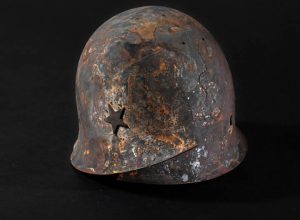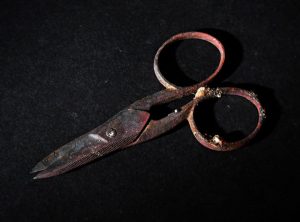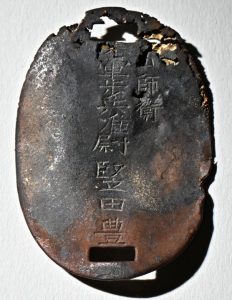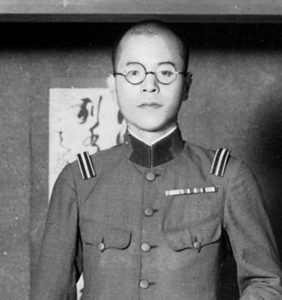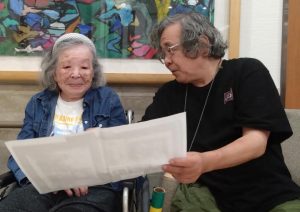Silent Witness: Belongings of military officer
Aug. 5, 2024
Family sorrow conveyed
Without chance to call him “father,” daughter reunited with remains
by Kyoko Niiyama, Staff Writer
The area around Hiroshima Castle in the city’s Naka Ward is now crowded with many overseas visitors. In the past, the Chugoku District Military Headquarters, which managed military affairs in the Chugoku region, was located in this area. On August 6, 1945, the headquarters was almost completely destroyed by the atomic bomb dropped on the city by the U.S. military. The bombing is considered to have killed most of the soldiers and the civilian employees of the military there at the time. Many belongings found among the ruins at the site are now archived at the Hiroshima Peace Memorial Museum, also in Naka Ward. Each of the belongings gives insight into the lives that were suddenly taken and the everyday life that was abruptly ended, as well as the sorrow of the families.
On an oval-shaped piece of metal measuring four centimeters in length and three centimeters in width are the engraved words, barely visible, “Yutaka Tateda, Infantry Warrant Officer, Fifth Division.” The item is an identification tag for Yutaka Tateda, 42 at the time, who died in the atomic bombing at the Chugoku District Military Headquarters. ID tags had a soldier’s name and regiment unit engraved on them for verification of identity in case of death in war.
At the time of the bombing, Mr. Tateda worked for a military administration department in charge of accounting as an army major. The headquarters was located around 800 meters from the hypocenter. The entire area was destroyed and became engulfed in flames. Found in the ruins afterward were countless, unidentifiable bodies. Mr. Tateda’s body was identified because he had held on to the ID tag in his hands. Mitsuko Yamanouchi, 92, Mr. Tateda’s oldest daughter who lives in Tokyo, recalled memories of her father. “While alive, my father said, ‘I’ll definitely be holding on to this ID when I die.’”
Mr. Tateda was a career military officer who was transferred to a variety of assignments when the Sino-Japanese war broke out. After being wounded, he returned to Japan and was assigned to work at the Chugoku District Military Headquarters at the end of 1944. He began to live with his wife, Sawame, and daughter, Mitsuko, in the area of Danbarahigashiura-cho (now part of Minami Ward). Because Mr. Tateda had lived apart from Mitsuko for a long time, he somewhat stood on formality, keeping his distance from her. He also “had a serious nature.”
One day, he scolded Mitsuko for drawing a line without using a ruler. “But when he scolded me like that he called me by my name ‘Mitsuko’ for the first time. I still remember that to this day,” explained Mitsuko. She felt he was being “fatherly.” She determined then that she would start calling him “father” the next day. Her plan never came to fruition, though, because the atomic bomb was dropped the following day.
On August 6, Mitsuko, then a first-year student at Hijiyama Girls’ High School (present-day Hijiyama Girls’ Junior and Senior High School), experienced the atomic bombing at school. Her mother, Sawame, experienced the bombing at home. The mother and daughter managed to survive and shortly afterward evacuated to a location outside the city. Intending to search for Mr. Tateda, who had not returned home despite their waiting for him, they returned to the ruined Hiroshima around two weeks after the bombing.
At the incinerated military headquarters, Mr. Tateda’s subordinate handed them a steel helmet that was cracked in the front. Mitsuko explained, “Bones had been placed inside.” That was Mitsuko’s reunion with her father.
She asked about where her father had died and dug around the spot with her hands. She found the wristwatch he usually had on as well as a pair of surgical scissors, which he kept as a good-luck charm ever since they were used to treat him when he had been wounded in battle. Mitsuko and Sawame brought the items back home as keepsakes of Mr. Tateda and carefully kept them at their home in Mihara City, Hiroshima Prefecture, where they had moved and lived by relying on relatives after the end of the war.
Sawame died in 2001. Because of her marriage, Mitsuko has lived in Tokyo for a long time, but she decided to donate her father’s belongings to the Peace Memorial Museum in the hopes that the items “are stored permanently in Hiroshima, the place he died.” Gen Yamanouchi, 63, Mitsuko’s oldest son who also lives in Tokyo, agreed with her decision. “Rather than our family holding on to the items, it would be better for them, as silent witnesses to the atomic bombing, to be seen by as many people as possible,” said Gen.
Taken by his mother, Gen used to visit the site where the military headquarters had stood on August 6 almost every year and speak with other people from surviving families. However, when he visited the area in place of his aging mother Mitsuko last year, there was no sign of anyone else related to the headquarters. Seventy-nine years since the atomic bombing, even members of the surviving families of victims have grown elderly. Mr. Yamanouchi explained his feelings about his grandfather’s keepsakes. “What happened then? I hope they continue to communicate the stories on behalf of those who were killed.”
(Originally published on August 5, 2024)

